|
May 1936 Radio-Craft
 [Table
of Contents] [Table
of Contents]
Wax nostalgic about and learn from the history of early electronics.
See articles from Radio-Craft,
published 1929 - 1953. All copyrights are hereby acknowledged.
|
In 1936, the FCC was busy regulating radio broadcasting via transcription programs
(pre-recorded segments), deciding that listeners deserved to be warned at least
every 15 minutes that they were not listening to a live announcer. A note on the
death of ARRL founder
Hiram
Percy Maxim was reported to have succumbed to a throat infection, which (my
conjecture) might have proven non-fatal had
penicillin
been in use in the day. Mr. Maxim is buried in
Rose Hill
Cemetery in Hagerstown, Maryland. Miniature 'pocket-sized' radio transmitters
and receivers were introduced for those who wore jackets with pockets large enough
to hold a box the size of a 1-liter bottle of soda pop. Lawsuits were already being
launched by music owners against radio broadcast stations over royalties. Dr. Compton,
of Compton Effect fame, was measuring cosmic rays aboard ships, and some of the
first radio-assisted blind landings were being performed in Germany.
The Radio Month in Review
Radio is now such a vast and diversified art it becomes necessary to make a general
survey of important monthly developments. Radio-Craft analyzes these developments
and presents a review of those items which interest all.
Hiram Percy Maxim-the friend of radio amateurs who died last month.
Hiram P. Maxim Dies
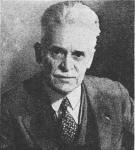 Last month, one of the best known and respected
radio men passed away; Hiram Percy Maxim, 67-year-old president of the American
Radio Relay League and the International Amateur Radio Union, succumbed to a throat
infection, on a trip to the West Coast. Last month, one of the best known and respected
radio men passed away; Hiram Percy Maxim, 67-year-old president of the American
Radio Relay League and the International Amateur Radio Union, succumbed to a throat
infection, on a trip to the West Coast.
Mr. Maxim besides being a strong supporter of amateurs was also known for his
inventions, especially the silencers used on fire arms, motors, etc.
One of his guiding beliefs was that the scientific progress of the world depends
on its amateurs - those who experiment "for the fun of it" and whom he (rightly)
credited with many basic developments.
Mr. Maxim will long be missed by the American radio amateurs who looked to him
for support in maintaining their rights.
F.C.C. Rulings on Broadcasting
During the past month, the Federal Communications Commission made two important
rulings regarding broadcasting. The first of these concerned that important subject
- transcription programs. The new ruling states that it is only necessary to announce
the program as a recording at the beginning and end of each 15-minute program. This
will, no doubt, increase the use of such programs.
The second ruling concerned duplication of programs and instigated an investigation
into the possibilities of reallocation of stations to prevent such program duplications
in rural sections where there are only two or three "local" stations.
Ultra-Short-Wave Broadcasting
The transmission of programs on ultra-short waves, notably 41 and 31.6 megacycles,
which was started some time ago, to advance transmission of high-fidelity programs
made a notable advance, last month.
Station W8XWJ, the companion station to WWJ, operated by the Detroit News started
regularly scheduled programs on the 31.6 megacycle band - the first station to transmit
regular service on these frequencies.
According to the F.C.C., progress on these frequencies is slow, due to the lack
of receivers to pick up the programs, but the new "crop" of all-wave sets which
will soon appear covers frequencies higher than 56 megacycles and this encouragement
will no doubt spur on the efforts of the half-dozen owners of these high-fidelity
stations.
Violet Ray Sound Recording
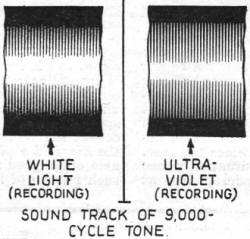 New process for photographically recording
sound on motion-picture films which is expected to "open a new era of realism" in
the reproduction of music and speaking voices was demonstrated last month at a meeting
of the Society of Motion Picture Engineers. New process for photographically recording
sound on motion-picture films which is expected to "open a new era of realism" in
the reproduction of music and speaking voices was demonstrated last month at a meeting
of the Society of Motion Picture Engineers.
The present method uses an ordinary incandescent lamp as a light source in recording
- but "white" light has some components which are almost impossible to focus sharply
in order to get a distinct reproduction of sounds :- this results in distortion.
In the new method, a light filter is inserted in the light path so that only
the ultra-violet rays reach the sound track of the film. This filtered light "paints
the sound image on the film" more distinctly than the older method.
To the right, a comparison of the sound tracks for ordinary light and ultra-violet
light.
Miniature "Spot" Broadcast Station
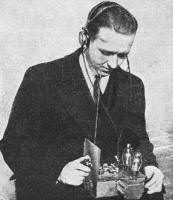 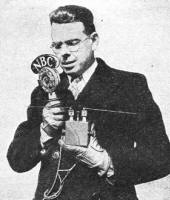 A tiny transmitter that fits in the palm
of the hand and operates on a wavelength of 1 meter was announced last month by
the NBC for use in spot broadcasts at remote points. A tiny transmitter that fits in the palm
of the hand and operates on a wavelength of 1 meter was announced last month by
the NBC for use in spot broadcasts at remote points.
The transmitter has a range of about 4 miles and because of the extremely high
frequency, its penetrating power through steel buildings, etc., is remarkable. This
new device will enable announcers to move about at will without being burdened with
cumbersome equipment since it weighs less than 4 lbs. with batteries, measures only
3 ins. square. The power output is about 0.2-watt; it uses a tiny "acorn" tube.
As an accompanying unit, a 1-meter receiver has also been developed, using a
special super-regenerative circuit, to pick up the signals from the pocket transmitter
and feed them into a telephone line so that they can be transferred to the network
outlet (station).
The development of these ultra-high-frequency units will greatly facilitate the
transmission of sporting events, etc.
Views of the new pocket radio transmitter (left) and receiver (right).
Networks Sued in Music Fight
Since our first announcement in March, 1936, Radio-Craft, of the fight between
ASCAP (or, rather, Warner Brothers Pictures, Inc.) and the national broadcast networks,
over the price to be paid for music transmitted, several developments have taken
place.
First, both NBC and CBS have been guilty of using music which was banned by Warner
Brothers (as might be expected because of the large amount of music controlled by
the latter), and both networks were haled into court, last month!
Second, the quarrel is no nearer to an amicable settlement than it was two months
ago - which is surprising, considering the large sums involved!
New Use for Public Address in Mines
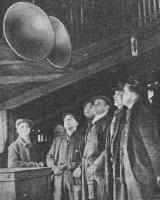 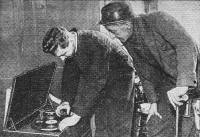 A new and novel use for P.A. equipment came
to light, last month, when news was received that a complete P..A. system had just
been installed in a colliery at Ogmore Vale, Wales. The P.A. system is used to send
safety-first rules, from phonograph records, it is also used as a call system to
all parts of the mine. A new and novel use for P.A. equipment came
to light, last month, when news was received that a complete P..A. system had just
been installed in a colliery at Ogmore Vale, Wales. The P.A. system is used to send
safety-first rules, from phonograph records, it is also used as a call system to
all parts of the mine.
To the left and right are two views of the P.A. installation in the Welsh coal
mine, showing the phonograph equipment for sending safety talks, and one of the
speaker installations in the shaft.
1936 Outlook is Encouraging
According to a report from the Radio Manufacturers Association, last month, the
radio industry is looking forward to another excellent year. According to the RMA
report, "Some industry leaders even feel that the record-breaking sales of 1935
will be exceeded in 1936."
The Presidential election campaign in which radio (and P..A.) will play an important
part as well as the soldiers' bonus distribution which will take place, probably
in June and July, all point to increased business for "radio" manufacturers.
Broadcast station advertising in 1935 also hit a new high. The total sale of
time on the air by the nation's networks and independent stations amounted to $87,523,848
in 1935 which represents a gain of 20 per cent over sales in 1934.
In the annual report of the Radio Corp. of America for 1935, the net profit was
$5,126,873 which compares with $4,249,264 for 1934 - each quarter of 1935 showed
a gain over the corresponding quarter for 1934!
Cosmic-Rays on Shipboard
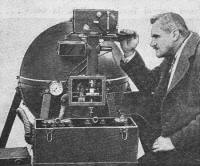 The first time that a cosmic-ray recording
device has been installed on a ship travelling through northern and southern hemispheres
for the purpose of checking the variations of cosmic-ray activity at different parts
of the globe was announced, last month, by. Dr. Arthur Holly Compton, of the University
of Chicago. The first time that a cosmic-ray recording
device has been installed on a ship travelling through northern and southern hemispheres
for the purpose of checking the variations of cosmic-ray activity at different parts
of the globe was announced, last month, by. Dr. Arthur Holly Compton, of the University
of Chicago.
Dr. Compton, who received the Nobel prize in 1927, installed a unit consisting
of a shield of lead through which cosmic rays but not radio-active rays may pass,
and an electronic indicating device (similar to a Geiger counter) attached to a
film recorder.
To the right is Dr. Compton with his cosmic ray unit.
"Blind Landing" in Britain
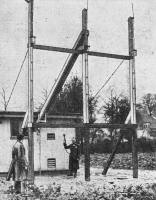 The first "blind landing" equipment at a
British airport was installed, last month, at Heston Airport. The landing arrangement
uses the system devised in Germany by the Lorenz Company and originally installed
at Templehof Airport in Berlin. The first "blind landing" equipment at a
British airport was installed, last month, at Heston Airport. The landing arrangement
uses the system devised in Germany by the Lorenz Company and originally installed
at Templehof Airport in Berlin.
This system consists of two radio beacons at either end of the airport. Each
sends out constant call signals and information to guide the pilot to a safe landing.
To the left, engineers testing the Heston blind-landing rig.
European Radio Happenings
During the past month, several interesting radio news items have been received
from various parts of Europe.
It is expected that within the year television will be inaugurated in England.
The Post Office authorities also announced that telephone-television service probably
will be established between London and Birmingham, using a new type of cable (presumably
a coaxial cable) which enables television views to be sent over nearly 100 miles
of land lines.
The Postal Ministry in Berlin announced that arrangements had been made to send
television views of the Olympic games over the Berlin television station. This is
the first time that such an important outdoor gathering has been televised. In addition
to the television views, direct short-wave transmissions of the games will be made
to at least 19 different countries from the new "radio-house" which has been erected
for the purpose.
In Russia, installations are being made of 5 radio searchlights or beacons over
the air lane between Moscow and Vladivostok. These are intended to aid fliers in
fog and night flying.
Extensive plans are being made to broadcast daily from the liner Queen Mary during
her maiden voyage to New York. A squad of technicians of the B.B.C. will install
microphones at strategic points throughout the huge ship, from the engine room to
the crow's nest, to convey impressions of the multifarious activities of passengers
and crew.
A rumor was received that in order to finance the expensive television experiments
in Paris, the French Post Office Department would accept publicity or advertising.
The nature of the advertising was not mentioned.
Posted June 1, 2017
|

















